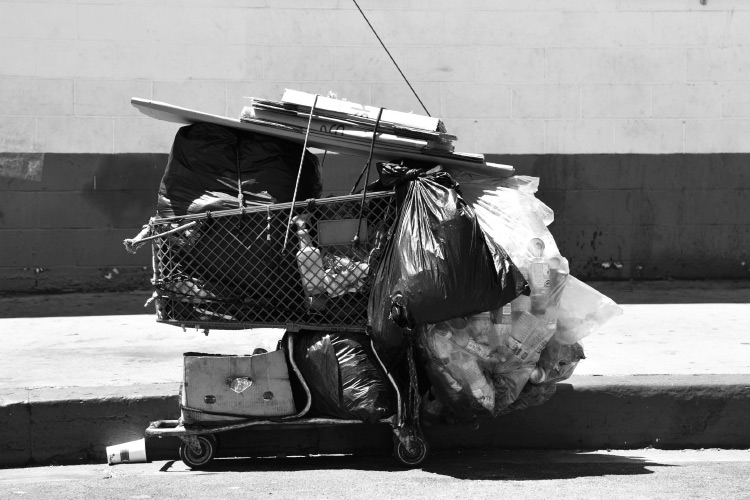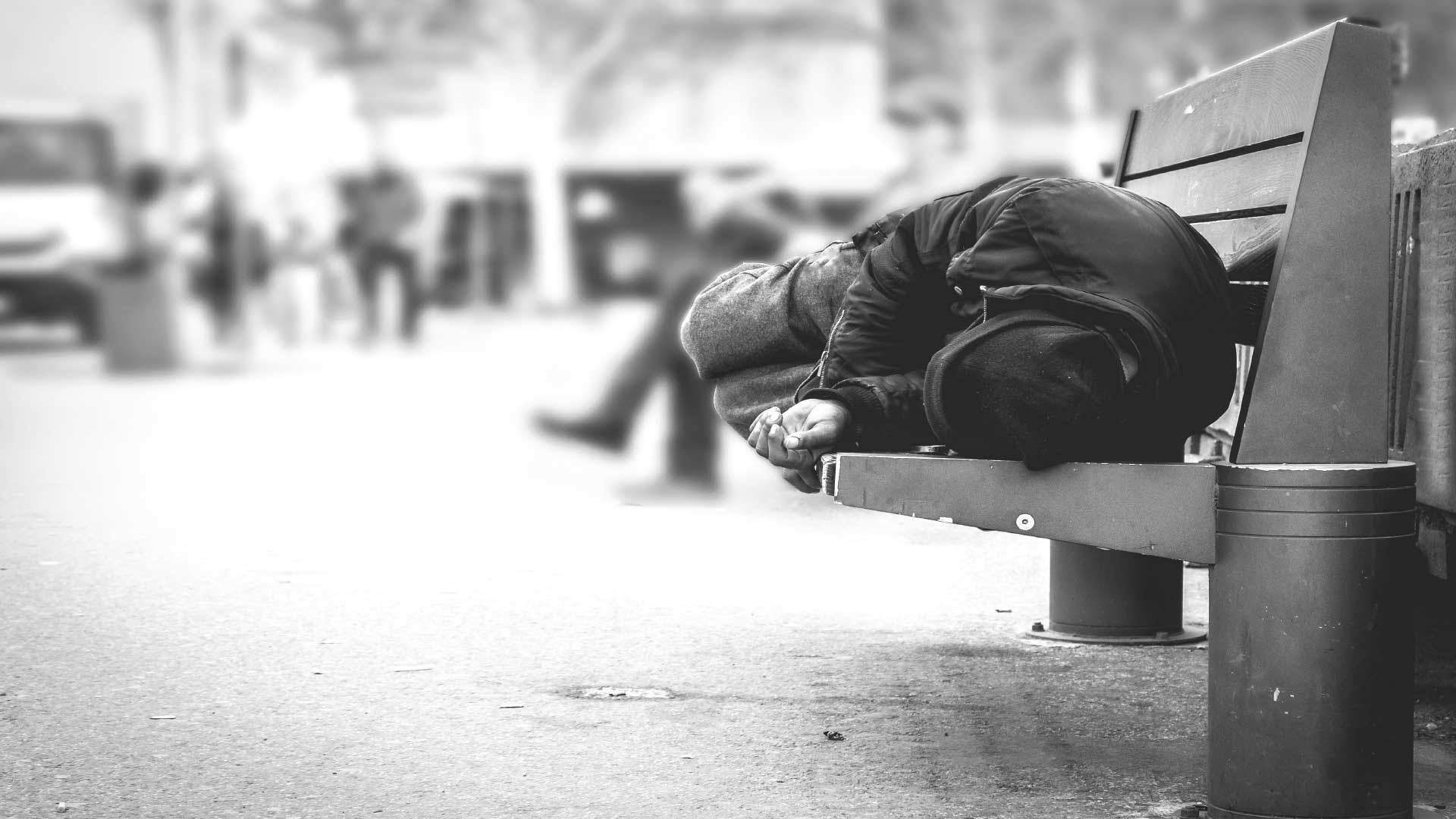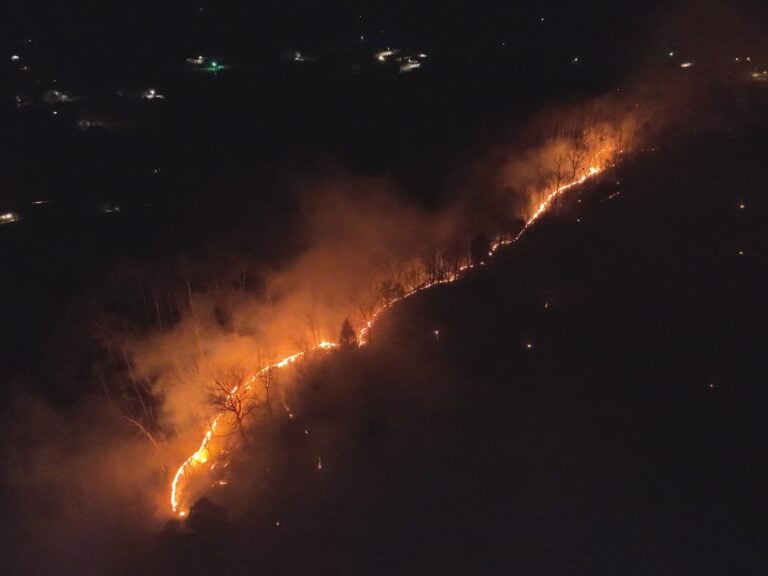The Hard Truths of Homelessness
I came to Asheville for the mountain biking. I had a communications degree and worked in advertising as a commercial photographer. It paid well, but the work was seasonal and intermittent. So when I was asked by a sales manager to join an aerial photography start-up for high-end clients’ real estate, I jumped at the offer.
I sold just about everything I owned to finance the training, equipment, and logistics. I would be staying in the sales manager’s condo beside a beautiful mountain lake outside of Asheville.
As I sat in my SUV above the lake, I was in a wonderful mood. My cat and all of my belongings were in the truck with me. A check and a new apartment were waiting for me, and along with the excitement of a new job I liked, I felt extremely lucky.
But then my phone rang. “The deal is off,” my sales manager said. He had secretly gone to work for another company. “You need to find something else.”
I was out of a job and out of options—and also without a check. I had 38 cents in my pocket and about a quarter tank of gas.
I scrambled on the internet and found someone on Craigslist advertising a free couch surf. I drove on fumes to the next town to meet him. He told me to meet at a fast food restaurant near their place in a few hours and he would take me to his place. As I pulled into the parking lot, I ran out of gas and coasted into a parking space. I waited for hours and never heard from him.
My year on the streets had begun.
I was 61 years old. My parents were both dead, and I had no family or close friends to turn to. I’d always told myself that if I ever ended up in this situation, I’d just kill myself. I even found the box cutter that I kept in the car and considered it. But I had my cat with me, and I loved him more than anything. I needed to make sure that he was okay first. So I put the blade away.
The Shelter
You probably won’t be welcomed when you try to get into a shelter. They’re often run by resident homeless volunteers who aren’t usually very friendly. No one hates the homeless like other homeless people. It’s a major reason why the homeless often choose to camp outside or live in their car. I lived in my truck with my cat for a few weeks, but I soon realized that I couldn’t take good care of my cat, so I found a no-kill animal shelter who was willing to take him. It was a hard goodbye. He was all I had left.
Once I was in the shelter, I very quickly volunteered to work the front desk. Volunteers were allowed to stay in the shelter during the day, and we had other privileges like eating first before the crowds come. The non-volunteers who stayed at the shelter had to leave right after breakfast and stay out until evening. You have to basically wander the streets all day with all your belongings. I only had to do it for the first couple of weeks before I became a volunteer, and it’s not fun. Everywhere you go, people watch you with wary eyes, expecting you to steal or vandalize something or they assume you’re making a drug deal. There’s usually nowhere to go to the bathroom or sit down. It’s exhausting. You’re not really a person anymore. You’re homeless. People put you safely into a narrative involving faults you must have that they don’t—to protect them from thinking that it could happen to them. Once you are homeless, that’s all that defines you. Your real past is gone, and everyone assumes that you must be a junkie, seriously mentally ill, or a criminal. It follows you for years after. I recommend moving and not telling anyone. Start over.
Shelters aren’t much better than the streets. I was sick all of the time, often stuck in a small dirty space with several other sick, coughing residents. Many homeless are virulent anti-vaxxers and refuse the vaccination that would help reduce the infection rate. I didn’t sleep much, either. In a shelter it’s noisy with coughing and snoring and fighting.
You aren’t safe, in a shelter or on the street. It can get violent, and you’re absolutely going to be robbed at some point. Most likely more than once.
Whenever an attractive woman came through, it was almost always the same story. She would hook up with a homeless man for “protection,” and he would then proceed to beat and rob her. Black eyes, missing front teeth, and casts on arms were the usual look within a short time.
I tried to show kindness to the people who came through, but eventually I developed the same compassion fatigue that sets in with everyone. Whether they are homeless because of mental illness, addiction, rejection by their family, or bad luck, they often tend to be assholes in their behavior towards others. It’s a prime reason no one wants them in their homes. Lying, stealing, vandalism and violence are common. I was threatened several times while working the front desk, and I often had to stop violent altercations or otherwise put myself in danger.
The Homeless
The reasons people were in the shelter or on the street varied. A large percentage of the population were prisoners recently released from long sentences. They were so damaged and institutionalized that I didn’t have much hope that they would ever do very well. Another group were LGBTQ kids and even some adults who had been thrown out of their homes and had nowhere to go.
For middle aged and older men, alcoholism was the main cause. Multiple DUIs and losing their drivers’ licenses generally sent them over the edge financially, and their personal relationships were damaged to the point where they had nowhere to go. Of course, hard drugs had a part to play, but the majority of the heavy druggies stayed on the street in cars or camping out.
“You’re not really a person anymore. You’re homeless. It’s all that defines you. Your real past is gone, and everyone assumes that you must be a junkie, seriously mentally ill, or a criminal. It follows you for years after.”
It seemed that almost everyone was getting a disability check, but instead of using it for shelter or food, they just spent it all on a big week-long meth party at the beginning of the month as soon as they were paid. Most would split cheap motel rooms for a few days, and the shelters were largely empty for the first week of the month. One of the workers at the nearby hospitality house wrote a poem about the “Five-Day Check Motel” phenomenon. Then, when the check was spent, they would panhandle or fly signs. Food, shelter, and clothing are usually freely available at the shelters, so they spent that money on cigarettes, alcohol, lottery tickets, and drugs. I never saw anyone panhandle or fly a sign that wasn’t going to buy alcohol or drugs with it. I don’t ever give money to panhandlers because of that. I know it’s just going to hurt them. I wasn’t aware of anyone who was trying to get their life back together ever panhandling or flying signs. I suppose it’s possible, but I just never saw it. Don’t give money to panhandlers would be my advice. Donate to shelters or other aid organizations instead.
One guy at the shelter—a fellow who had been in prison for 25 years and was really a nice guy—was waiting on his disability back pay to get a place and a new start in life. We had great hopes for him. But then he just disappeared one Thursday. While I was on duty at the front desk the following week, he called from jail in South Carolina, begging to be allowed back. He had received his check, and then he’d immediately been robbed by his daughter and her friends who had lured him to a crack party in South Carolina. They disappeared with his money, and he was arrested in the aftermath. There were lots of stories like that.
Another guy at the shelter had lost his guitar shop business and his home after he was busted for a couple of small pot plants on his back porch and sentenced to 1 1/2 years in jail. But unlike most people at the shelter, he was getting up at 4:30 every morning to ride his bicycle several miles in the dark to get to his new job at Subway. He eventually found a roommate situation with an old friend and was the first to escape back to a semblance of normal life.

Problems and Solutions
The modern homelessness epidemic is caused by lack of adequate mental health care. It started back in the 1980s when Ronald Reagan closed the mental hospitals to the nonviolent mentally ill and put tens of thousands of at-risk people on the street. They literally put them on a bus, drove them to a big city, and kicked them out on a backstreet to fend for themselves. Basically all the guys from One Flew Over the Cuckoos Nest were on the street. The problem has grown substantially since that time to include all sorts of folks who have fallen through the ever-widening cracks in our society.
I doubt even a guaranteed income would actually keep everyone off the street since a surprising percentage of the hard core people already receive disability payments but don’t use it for housing or food. Quite a few folks are essentially professional homeless who’ve been on the street for decades and will probably die there. They winter in Florida and come to the mountains for summer. Many get apartments only to get kicked out because they simply can’t live with other people without fighting or robbing their neighbors.
The hospitality houses you can visit during the day are a valuable resource. There are counselors to help navigate the various programs for housing or healthcare, and you can often use them as an address for food stamps or job applications and to receive mail. There were also showers and toiletries available, and safe storage bins to store your belongings, which is a huge issue on the street. They have coffee and pastries, and it gives people a place to go after leaving the shelter after breakfast or waking in your car or tent.
The most financially advantageous approach to homelessness that communities have tried has been to just give them a home. It’s extremely expensive keeping people on the street. I’ve watched people blow thousands of dollars in ambulance and emergency room fees faking an illness just to get out of an extremely easy three-hour, once-a-week work requirement to stay in the shelter. We also had to make several calls for ambulances to take care of overdoses of so-called synthetic marijuana like Bizarro. They’d smoke the whole package in the bathroom and end up out front clinging to a light pole, screaming that demons were trying to drag them to hell. The demons were actually the EMTs trying to get them to the emergency room.
Telling addicts to clean up before they get housing doesn’t really work. It’s incredibly difficult to quit drugs or alcohol while homeless. Also, a good percentage of the homeless population aren’t ever going to be able to hold a job and are just so broken as people that the best thing we can do is just take care of them. Compassion for the unlikable is hard but necessary. It’s easy to feel empathy for a child immigrant separated from their family. It’s a different thing when it’s the scary guy yelling and dancing on the corner.
“The ‘code purple’ homeless are the most narcissistic, entitled, and angry people I’ve ever encountered. I don’t think a guaranteed income and free housing for all will help them at all, really. ”
In the winter, the shelters would have a system called “code purple” whenever the temperature dropped below freezing. During code purple, everyone was allowed in, giving a place out of the cold to people who couldn’t normally stay for a variety of reasons. They were the felons and the hardcore drinkers and drug users, the folks who couldn’t or wouldn’t stay sober and pass a breathalyzer test. They seemed to move from the street to the jail and back again like a three-month tide. It’s a very different group from the regular residents who were vetted and basically just glad to have a place to stay while trying to get housing or disability or social security going.
For the code purple folks, the street is more of a permanent thing. This mixing of a largely criminal element with the general population is a constant source of problems for the shelters. There was constant trouble with them, and robberies, vandalism, violence, and general mayhem were the norm. They often ripped everything off the walls and tried to destroy anything they could. The shelters where I stayed no longer take part in code purple because of the cost and pointlessness of trying to help them. It’s the most narcissistic, entitled, and angry group I’ve ever encountered. I don’t think a guaranteed income and free housing for all will help this demographic at all, really.
I suppose it depends on the individuals involved at the time you’re there, but there was also quite a bit of corruption in the management of shelters, from stealing donations to outright embezzlement of millions of dollars. I think it’s gotten better in the ensuing years. But the director of the last place I stayed was the most fervent Evangelical I knew, constantly and loudly proclaiming his love for Jesus. He disappeared with over $2 million of the shelters funds. It’s my understanding that they still don’t know where he is.
However, it’s impossible to overstate the importance of the various area churches’ involvement in taking care of the homeless. I’ve never been a churchgoer, and I sometimes resented being forced to attend church services at shelters, but really it was a small price to pay for their incredible generosity and compassion. Whether working in association with other churches or just running the shelter as a mission to help spread their message, the shelters I dealt with were all operated by religious organizations. Secular charities also contributed a great deal to the homeless.
Home
A little less than a year after it began, I was able to get my early social security started and move into an apartment. The shelter where I was staying at the end helped me with housewares, food, and some furniture, as well as covering my deposit on the place. They even helped me move. When you’ve lost everything, kindnesses like that are priceless.







